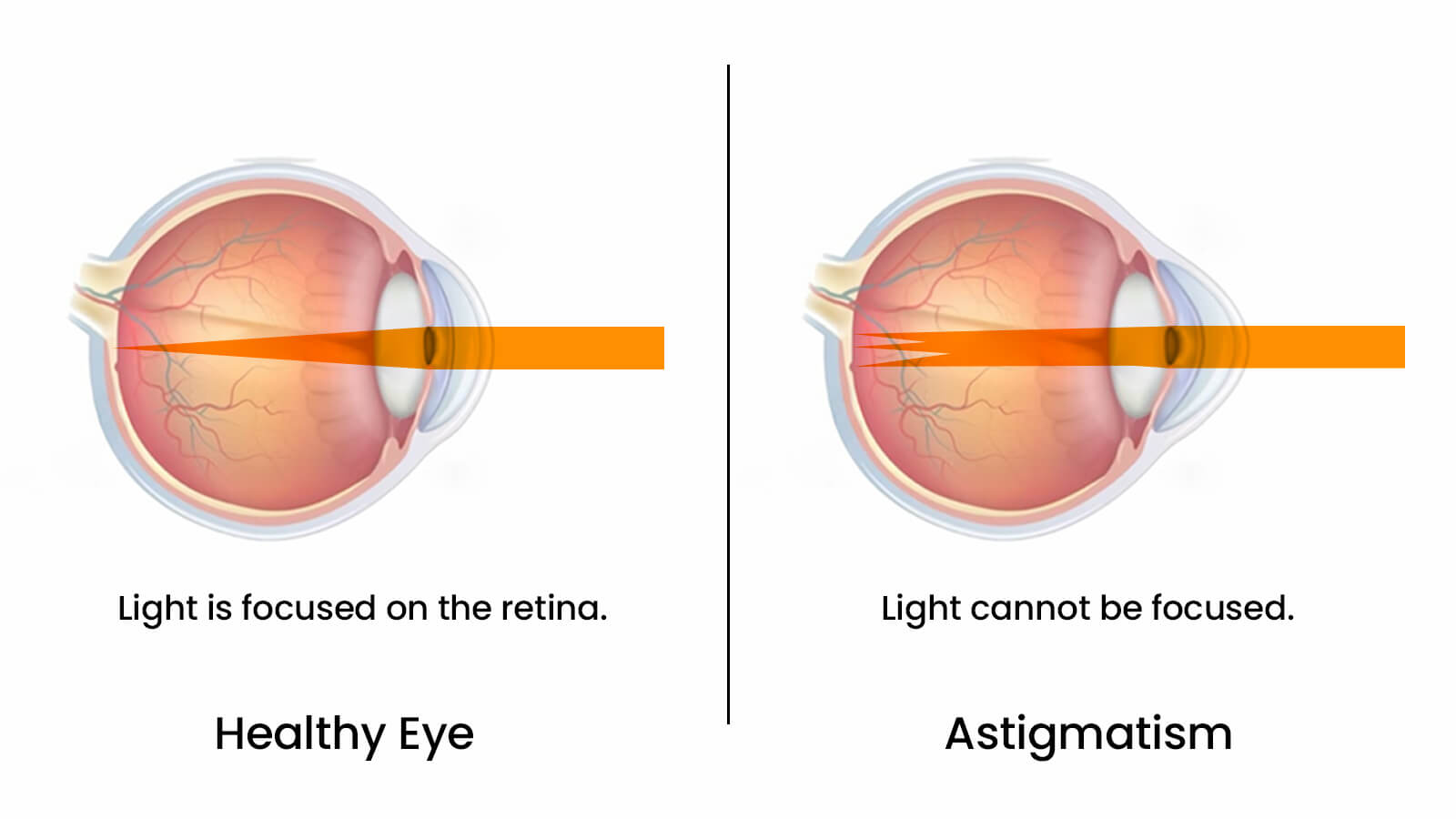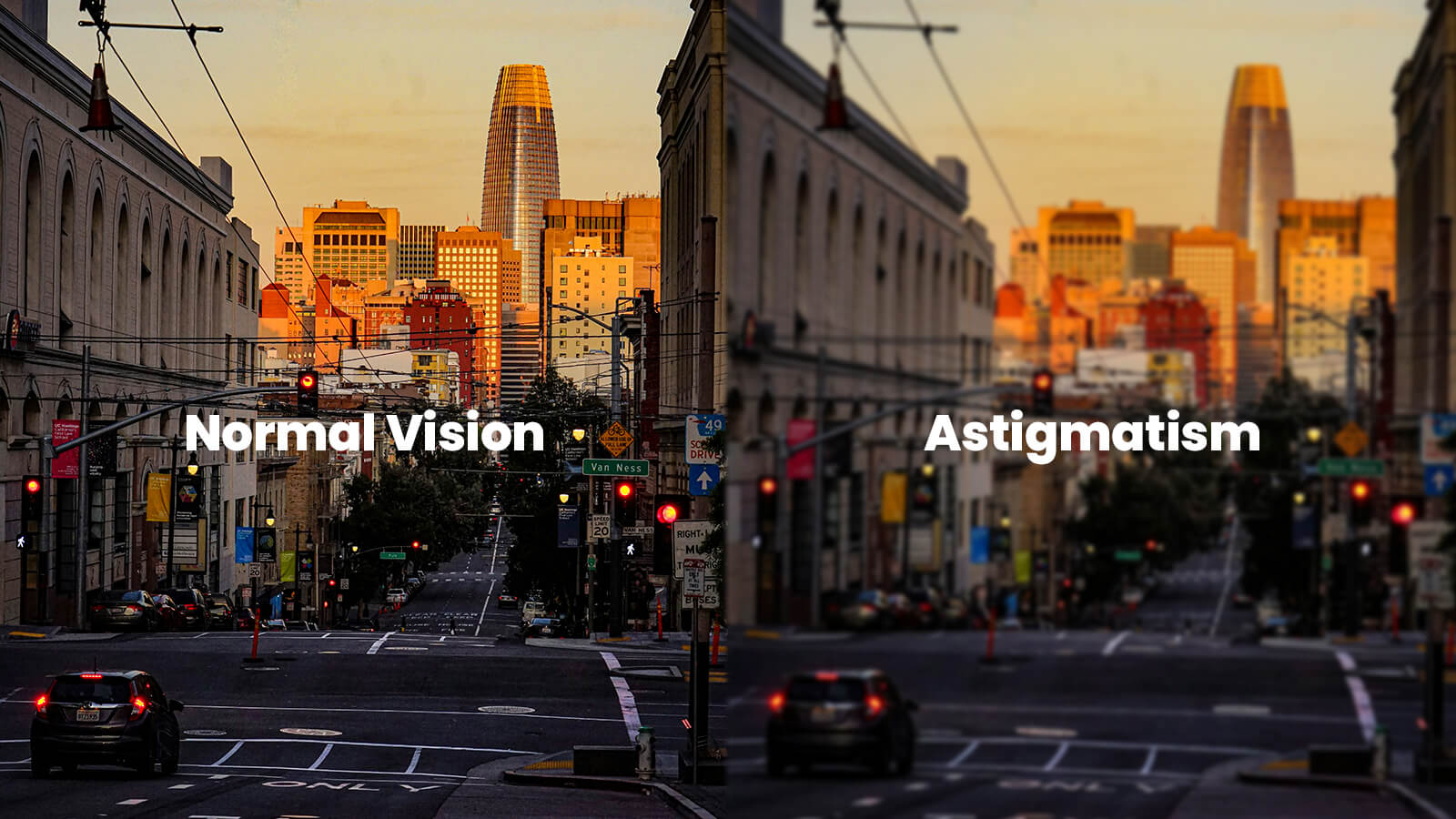
Guide to Picking Glasses That Suit Your Face Shape Perfectly
February 27,2023

What is Boho Style? A Comprehensive Guide to Boho-Chic Fashion
February 13,2025

Virtual Glasses Try On - Find Your Perfect Pair Online
April 02,2024

UV Protection Glasses VS. Blue Light Glasses - Vooglam
July 20,2023

Newest Style Modern Trendy Mens Glasses | Vooglam
March 01,2024

Stylish Reading Glasses: Blending Fashion with Functionality
February 16,2023

What are photochromic lenses & glasses?
September 22,2023

Brown Eyes: The Beauty of the Most Common Hue
September 01,2024

The chubby face glasses for round face female
August 02,2023

What are prisms in eyeglasses?
March 20,2023

What are Bifocal Lenses? - Vooglam
April 14,2023

How to Read Your Eyeglass Prescription?
March 11,2023
What is Astigmatism? Causes, Symptoms, and Eyes Care Tips
What is astigmatism?
Ever wondered why lights look like starbursts while your friends see perfect circles? The refractive power of the eyeball on each meridian is uneven. After the parallel light enters the eyeball, it cannot focus on the retina. This is due to the eyeball's different refractive power on each meridian. It forms some scattered focal points instead. Understanding astigmatism vs normal vision helps you recognize when it's time to show off your vision with the right eyewear.

What causes astigmatism?
Astigmatism is a refractive error. It happens when the cornea, the eye's clear outer layer, is irregularly shaped. This causes light to focus unevenly on the retina. Unlike normal vision vs astigmatism, where light focuses perfectly, astigmatic eyes scatter light in multiple directions. Kids are more likely to have astigmatism if one or both parents have it. Poor eye habits, such as reading in poor lighting or squinting, can also cause astigmatism.
Through optometry, the visual effects of astigmatism in patients are identified. Astigmatism is an optical issue. It happens when the eye's cornea or lens is irregularly shaped. This prevents light from focusing properly on the retina. The irregular curvature causes light to scatter. This creates multiple focal points, leading to blurred or distorted vision. This condition can affect vision at all distances. It often occurs with other refractive errors, like myopia (nearsightedness) or hyperopia (farsightedness).
Astigmatism vs normal vision - What's the Real Difference?

Astigmatism can't form a clear image. Adjusting focus or moving the target makes no difference. The lines look blurry. People with astigmatism may have poor vision compared to those with normal vision. When comparing astigmatism vision vs normal, the most noticeable difference appears when viewing lights with astigmatism - they appear stretched and distorted, while lights with and without astigmatism show dramatically different patterns. This can be a problem, especially when driving at night. Those experiencing eye astigmatism lights often describe halos, streaks, or starburst patterns that make night driving particularly challenging.
Ready to see the difference for yourself? Vooglam's precision-crafted lenses can transform your blurry world into crystal-clear vision. Browse our prescription glasses collection and find frames that match your unique style!
What is a prescription for astigmatism?
An optometrist or ophthalmologist usually tests for astigmatism after a refraction test. Understanding the difference between astigmatism vs no astigmatism starts with reading your prescription correctly. An astigmatism prescription specifies the type and power of lenses to fix an irregularly curved cornea or lens. The key pieces of information are as follows:
Sphere (SPH): This indicates nearsightedness (myopia) or farsightedness (hyperopia) in diopters. Negative values indicate nearsightedness and positive values indicate farsightedness.
Cylinder (CYL): This measures the amount of astigmatism in diopters. It shows how much correction is needed to compensate for the irregular curvature of the cornea or lens. This is what distinguishes astigmatism versus normal prescriptions.
Axis: This indicates the direction of the astigmatism, ranging from 0 to 180. It tells the direction to apply the cylinder correction to fix the astigmatism.
A complete vision prescription will also include other info, like OD, OS, and PD. Learning to read a vision prescription will help you understand your vision status. Pro tip: Upload your prescription to Vooglam's easy ordering system and we'll handle the rest!

Astigmatism can be roughly divided into:
- Regular astigmatism, irregular astigmatism;
- Astigmatism along the rule, against the rule astigmatism, oblique axis astigmatism;
- Simple myopia with astigmatism. Simple hyperopia with astigmatism. Compound myopia with astigmatism. Compound hyperopia with astigmatism. Mixed astigmatism.
- Corneal astigmatism, crystal astigmatism, etc.
No matter your type of astigmatism, Vooglam has over 1,000 unique frame designs to help you express your inner funk while seeing clearly!
What are the hazards of astigmatism?
How does astigmatism affect vision? The contrast between astigmatism vs normal sight becomes clear when you experience these symptoms: Astigmatism can cause headaches and blurred vision. Astigmatism prevents the eyeball from focusing parallel light rays on the retina. This can blur or double vision. People with astigmatic vision often squint to see clearly. This leads to fatigue and worsens their vision. Astigmatism makes your eyes work harder to focus. The eye muscles tense up, causing headaches over time.
What causes to astigmatism getting worse?
Astigmatism usually develops in childhood and stays stable for life. However, several factors may worsen it:
- Eye damage: Even minor eye damage can change the shape of the cornea, potentially increasing the severity of astigmatism.
- Keratoconus: This disease thins and bulges the cornea. It can cause severe astigmatism.
- Certain eye surgeries: LASIK and similar procedures usually fix astigmatism. But, they can sometimes change the cornea's shape and worsen it.
- Ages: Although uncommon, some people may experience worsening astigmatism as they age due to changes in eye shape.
- Eye diseases: Some eye diseases, such as cataracts or dry eye, can cause astigmatism to worsen.
- Medications: Some, like antihistamines and decongestants, can cause dry eye syndrome. This can worsen astigmatism.
- Wearing contact Lenses: Incorrectly fitted contact lenses can change the cornea's shape. This may worsen astigmatism.
- Excessive eye rubbing: Long-term eye rubbing can fatigue the cornea and lead to increased astigmatism.
Don't let worsening astigmatism blur your style! Regular check-ups and quality corrective eyewear from Vooglam can keep your vision sharp and your look on point.

Protect your eyes, Vooglam recommends:
- It is best to have regular eye examinations, 1 to 2 times a year. Develop good hygiene habits and do not touch your eyes with your hands or other objects to avoid spreading eye diseases.
- The reading posture should be correct, keep a distance of 30cm~40cm, and the fonts should be clear and not too small when choosing reading materials.
- Do not rub your eyes. Protect your eyes and avoid eye trauma. This is the way to prevent pathological astigmatism.
- For patients with astigmatism, wearing prescription glasses promptly is important. The right prescription will reduce astigmatism symptoms. It will prevent eye fatigue when working and studying. Experience the difference between astigmatism view vs normal with Vooglam's premium lenses that offer crystal-clear vision at every angle.
How to buy prescription glasses for correcting astigmatism at vooglam?
Ready to transform your blurry world into HD vision? First get a valid prescription from your eye doctor and make sure it contains the necessary details to correct astigmatism. Next, browse Vooglam's stylish frame collection [ANCHOR: browse all frames] and choose a frame that suits your style and comfort. Then fill in your prescription details through the lens selection portal, and add additional features such as anti-glare or blue light blocking options.
Why choose Vooglam for your astigmatism correction? We're not just another eyewear brand - we're your vision revolution partner! With over 1,000 unique designs serving free spirits in 170+ countries, we make sure your glasses don't just correct your eye vision vs astigmatism issues - they showcase your personality too.
With Vooglam's user-friendly platform and affordable prices, finding the perfect astigmatism correction glasses has never been easier! Show off your vision today - Start shopping now and join over a million individuals who refuse to let astigmatism dim their sparkle!
 Note: This article provides general information about astigmatism and is not a substitute for professional diagnosis. Always consult with an eye care professional for personalized advice.
Note: This article provides general information about astigmatism and is not a substitute for professional diagnosis. Always consult with an eye care professional for personalized advice.

Vooglam Blog
Vooglam blog shares professional knowledge about eyeglass frames, lenses, etc., and provides help when purchasing and using eyewear products. At the same time, Vooglam focuses on fashion glasses to interpret the trend of glasses for you.

































